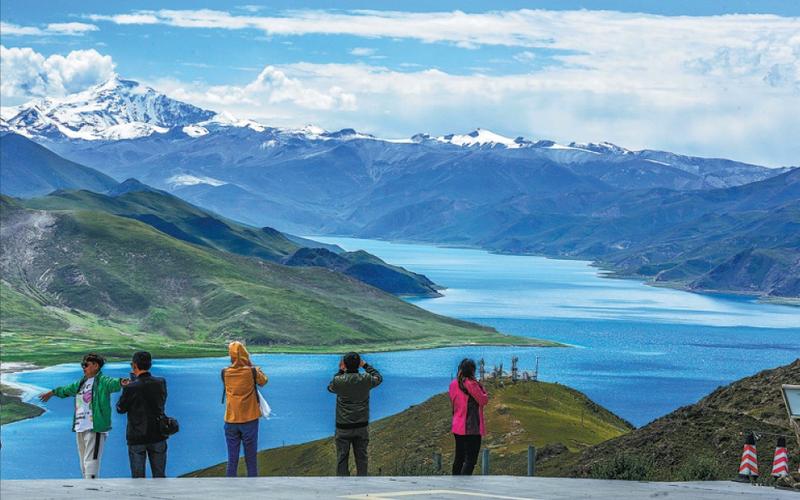 In this undated photo, visitors enjoy the scenery of Yamdrok Lake in Lhokha's Nakarze county, Tibet autonomous region. (PENG HUAN / FOR CHINA DAILY)
In this undated photo, visitors enjoy the scenery of Yamdrok Lake in Lhokha's Nakarze county, Tibet autonomous region. (PENG HUAN / FOR CHINA DAILY)
National political advisers have called for intensified conservation efforts for the Qinghai-Tibet Plateau, considering its sensitivity to global warming and huge potential in absorbing carbon dioxide.
The plateau plays a key role in the country's ambitious target of realizing carbon neutrality by 2060, said Yao Tandong, a member of the National Committee of the 13th Chinese People's Political Consultative Conference.
Considered a "treasured place", the Qinghai-Tibet Plateau can generate lots of clean energy, such as hydro, wind and solar power. Its annual carbon sink capacity covers a quarter of the country's total, said Yao Tandong, a member of the National Committee of the 13th Chinese People's Political Consultative Conference
Considered a "treasured place", the plateau can generate lots of clean energy, such as hydro, wind and solar power. Its annual carbon sink capacity covers a quarter of the country's total, Yao said. "If we can conserve the Qinghai-Tibet Plateau well, it's possible that it can absorb even more carbon."
Compared with the country's other regions, the "Roof of the World" is more prone to be affected by climate change, said Yao, who is also chief scientist on China's second comprehensive scientific expedition to the plateau.
ALSO READ: Efforts to stop creeping sand make headway on Qinghai-Tibet Plateau
The expedition, which started in 2017, is expected to last five to 10 years and study changes in climate, biodiversity and environment. The first such expedition to the plateau began in the 1970s.
Ever since the 1980s, global warming has triggered a temperature increase of 0.3 to 0.4 C in the plateau every decade versus 0.2 C in the country's eastern areas, he noted. Yao said the higher temperatures have melted glaciers, increased humidity, enlarged lakes and caused more precipitation. It also has made local residents subject to more disaster risks.
"Expanding lakes will inundate pastures, forcing herdsmen to relocate," he said.
Avalanches are a greater danger. In Ngari prefecture, Tibet autonomous region, residents and their animals have fallen victim to avalanches, even being 10 kilometers from where they originated, he said. In an avalanche, ice and snow can swoop down at over 100 kilometers per hour, burying everything in the way, he added.
Liu Yaming, who retired from her post as head of the China Meteorological Administration in January, is also well aware of the Qinghai-Tibet Plateau's situation.
In Lhasa, capital of the Tibet autonomous region, people used to wear thick clothes during summer. Now they can wear T-shirts and shorts, Liu wrote in a proposal she jointly submitted with Yu Rucong, a member of the Standing Committee of the National Committee of the CPPCC.
Warming is forecast to continue and the region's capacity to cope remains worrisome, said Liu, also deputy head of the Committee on Population, Resources and Environment of the CPPCC National Committee.
She called on the government to strengthen a climate change monitoring network to assist with early warnings and step up measures to restore the plateau's ecosystem and conserve its environment.
READ MORE: White paper issued on Qinghai-Tibet plateau ecological progress
"The network for comprehensive observation of the plateau's ecosystem and climate change should be further optimized," she said. "The monitoring, forecasting and early warning system for torrential mountain floods, debris flows and landslides should also be improved in key areas that have vulnerable ecosystems and high risks."
The country can make full use of the time to enhance wetland protection and desertification control so as to improve the region's environment, she said.
Contact the writers at houliqiang@chinadaily.com.cn


